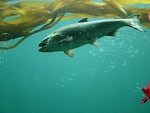
A Chinook salmon in saltwater.
Ken Balcomb / Center for Whale Research
The National Marine Fisheries Service, also known as NOAA Fisheries, is considering a request from several environmental groups seeking to list two types of Chinook salmon as threatened or endangered under the Endangered Species Act. One population lives along the Oregon Coast and the other farther south along the Oregon-California border.
Three environmental groups sent the petition last August showing that numerous threats have caused a sharp decline in spring-run Chinook salmon. Those groups are the Center for Biological Diversity, the Native Fish Society and Umpqua Watersheds.
Unlike fall-run Chinook, the spring-run salmon enter rivers still sexually immature and remain there through the summer.
“While they’re in the rivers in the summer there’s a lot more opportunities for factors that threaten the species, like pollution, hot water temperatures, habitat issues, to affect the species,” said Center for Biological Diversity senior attorney Meg Townsend.
Townsend said they’re specifically concerned about spring-run salmon, as their fall-run counterparts are doing better. However, the fisheries service said they’ll consider all the regional Chinook salmon populations for endangered listing together.
“They [the fisheries service] have said that if the spring-run were doing badly that listing the entire ESU may be warranted rather than separating them out,” Townsend said.
ESU refers to an Evolutionary Significant Unit, a population considered distinct enough to consider for conservation separately from the entire species. The fisheries service considered a request from environmental groups a few years ago to separate the spring-run Chinook salmon into their own ESU, but that request was denied.
“The spring-run are not separate from the fall-run,” said Gary Rule, natural resources management specialist with the fisheries service. “They’re not reproductively isolated from the fall-run. So they don’t meet the criteria to be separate.”
Rule said that despite fall-run Chinook salmon doing well, if the spring-run salmon alone are at risk of becoming endangered, that could warrant both groups being protected.
Townsend said that populations of coho salmon in the same area have improved since they were listed as endangered or threatened. She hopes protections for Chinook salmon will do the same.
Now, the fisheries service will look at the research and data submitted in the petition, as well as traditional ecological knowledge from area tribes, to decide if an endangered listing is warranted. They’re starting a 60-day request for information from the public.
The fisheries service decision is due by early August.
Editor’s note: This story has been updated to clarify the lifecycle of Chinook salmon. Spring-run salmon enter the river as fully-grown adults, but they are still sexually immature.